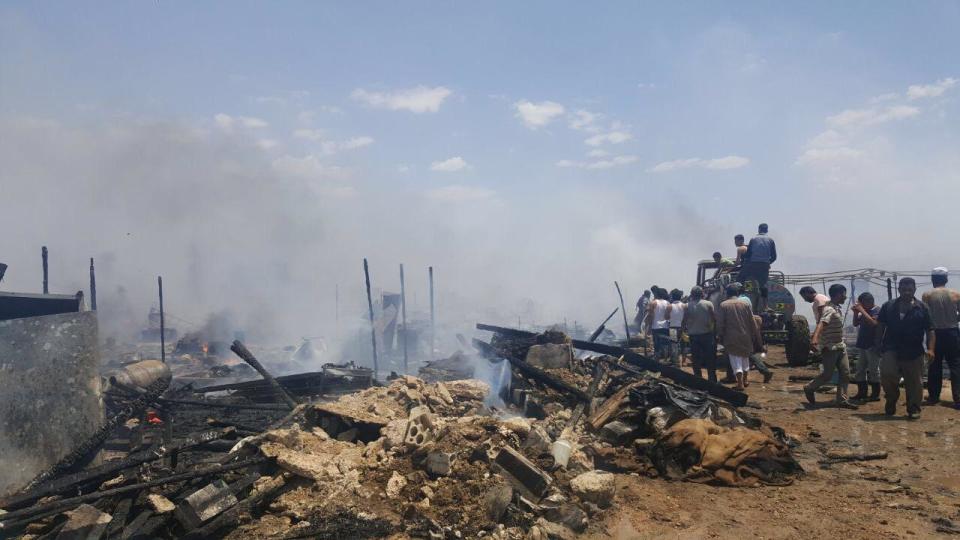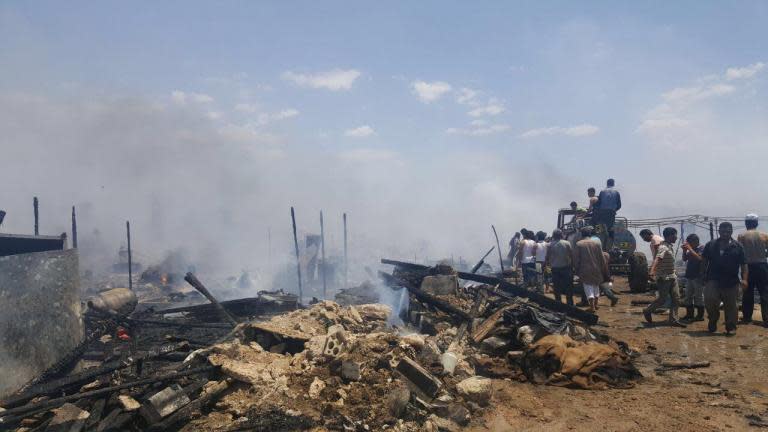Devastating fires in refugee camps highlight dangerous conditions Syrians in Lebanon are forced to live
“I don’t hope for much anymore. But I didn’t think we’d lose everything again,” said Bardah, originally from Deir Ezzour in Syria, her grandchild on one hip and gesturing around the burnt out remains of Qab Elias camp with the other. “But here we are.”
Lebanon is only half the size of Wales, and has a population of four million. It is currently home to an estimated 1.5 million Syrians who have fled over the border in the last six years of civil war, making around one in four people a refugee. The conditions for most, however, are abysmal.
The refugee response in Lebanon is no longer in the emergency stages - but two huge fires that ripped through Qab Elias and Mar Elias settlements earlier this month have shown just how precarious existence for so many Syrians here continues to be, trapped in a cycle of poverty and debt.
Refugees have brought macro benefits in the form of international financial injections to prop up the country’s antiquated water and sewage systems, as well as failing schools in rural areas which now teach more Syrian than Lebanese children. Despite the fact 71 per cent live below the poverty line, studies estimate that through the buying of goods and housing the refugee population has actually added millions to the Lebanese economy.
But in a country with a notoriously ineffective government - public services barely function - and where unemployment rates are already high, the authorities are wary of creating incentives for Syrians to stay.
Thousands of Palestinians who fled their homes during the 1948 Arab-Israeli War came to Lebanon, where they have been for generations: unable to claim citizenship, they are in effect second class citizens, confined to claustrophobic concrete ghettos still known as ‘camps’.
When Syria’s war broke out in 2011, the Lebanese government immediately outlawed the creation of official government-run camps in the hopes that the fighting would die down and Syrians would not choose to stay. The decision has made the job of aid organisations more difficult, as they must tread a line between providing the basic services Syrians need to survive, and making them - in the government’s eyes - too comfortable.
Most of Lebanon’s Syrian population actually lives in towns and cities - in abandoned buildings or farmsteads, or often at the mercy of landlords who threaten to expose families’ unregistered status to blackmail them into paying higher rents. Most have moved into already highly overcrowded Palestinian areas.
In the Bekaa Valley, however, fields of white tents and other makeshift settlements dot the landscape. The agricultural area is one of the poorest in the country, and the 39 per cent of Syrians who live here are some of the most impoverished.
“We are actually lucky that fires like this don’t happen more often,” Utpal Moitra, Unicef’s Chief Field Officer for the Bekaa and Baalbek-Hermel governorate said.
The camps most Syrians live in in the region have been built piecemeal, using whatever materials are at hand or help the UN and NGOs are able to give. As a result, many tents or semi-permanent breeze block structures are built too close together, and if they’re lucky enough to have an electricity supply, the wiring is often amateur.
Fires are very common, usually started by faulty wiring or because families use gas canisters to cook inside their tents. Normally, however, they are contained quickly, catching maybe one or two tents at a time.
In Qab Elias and Mar Elias, the July heat wave and wheat crop surrounding the sites meant the blazes had spread across almost the entire camps before fire services (run by volunteers in Lebanon) were able to arrive.
“The whole site went up in about 10 minutes,” said Lynn Bou Saba, who works for local charity World Vision at sites including Qab Elias. “No one had time to think, it was just run. So many families have lost their papers.”
Since the camps are not exactly built to high quality specifications, it’s not a surprise that fire safety procedures are not in place either. Qab Elias is surrounded by a ditch through which a small stream runs; when the tents first went up a few years ago, it was decided to put up a fence to stop children falling into it.
In the aftermath of the fire that proved to be incredibly dangerous - there was only one gate for all 700 people to scramble through. For those furthest away, it was a challenge to reach safety through the heat and smoke.
Residents said that there were a few fire extinguishers around the camp which they tried to use, but they had expired a year ago, rendering them useless as people’s homes and meagre possessions were destroyed in front of their eyes.
Rebuilding is already underway at a remarkable pace at both camps - and the new semi-permanent timber frame and concrete base homes, covered with tarpaulin, will be built to safer specifications. Most will even have their own latrines.
“In some ways it is a fresh start. But the trauma of it? A dead child? I don’t think anyone here would say it was worth it,” Ms Bou Saba said.
As some of the camp’s residents took a break from rebuilding to rest in the midday sun, a van from the Lebanese Red Cross pulled up, parking near the charred remains of what was the administrative centre.
Under a small gazebo for shade, they unload several new fire extinguishers, along with a small generator. One of the men nudges a fire extinguisher with his foot.
“If a fire that big breaks out again, they are probably useless to contain it,” he said. “But still. Like everything here, it’s better than nothing."

 Yahoo News
Yahoo News 

